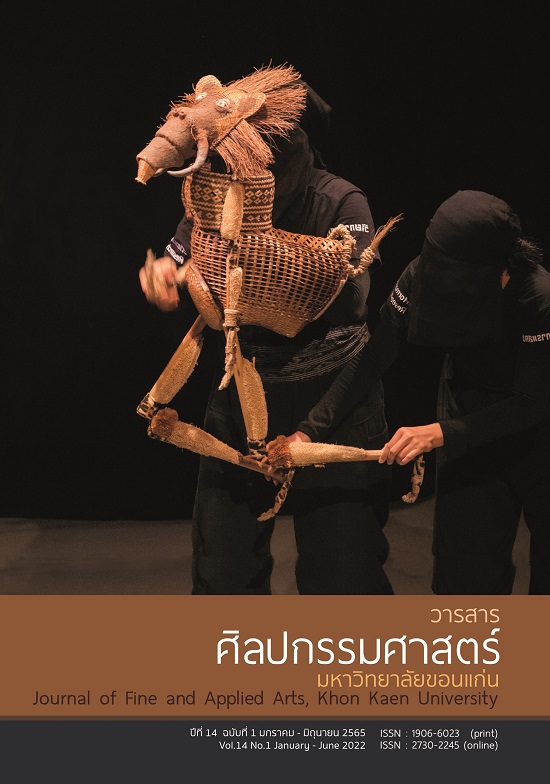A Research on Creation of Krisraya Sattrawut Performance
Main Article Content
Abstract
The objectives of this research were to study the history of kris dance performance and to create Krisraya Sattrawut performance. The study was based on documents, textbooks, related research papers, interviews, and participant observations.
The study results revealed that the culture of using a kris as a weapon was related to Javanese-Malay before the 1400s A.D. It was believed that kris represented Shiva and was possessed as a worshiped item, a supremacy ornament of a king or high ranking persons. It was also treated as an honorable ornament signifying the social status of the owner. In Thai society, a kris was an amulet as well as a spiritual refuge. A kris was used in ritual ceremonies such as Limon (a kind of Southern performance), Nora Rongkru (a kind of Southern dancing ceremony to pay gratitude to the ancestors), circumcision ceremony, and wedding ceremony - to show respect to the ancestors’ spirits as well as a prevention of misfortune. Kris dance appeared in a fighting performance called “Sila Kris” which was a fighting art using a kris as a prop in the dance to demonstrate fighting gestures. The performance sequence of orders were as follows- paying respect to the opponent by salaaming, dancing to pay a respect to teachers and ask for self-prosperity, dancing to estimate the opponent’s tactics via Kheun Phrom in which the dance gesture was in four directions and there was a threaten to the opponent while walking towards him with Dern Plaeng or Yang Sam Khum (to stalk forcefully), and finally the fighting process. Patani-style kris handle would be crafted in a form of the head of a humber bird which was very popular in the lower southern provinces in Thailand. The research on the creation of Krisraya Sattrawut performance which was newly created by the researcher consisted of 3 aspect: 1) costumes – performers would wear Bayu-Malayu Pattani court costumes, 2) music – using a Javanese oboe and a Malayu drum to control the rhythm of the dance together with the use of western musical instrument in playing contemporary music, 3) dance gestures –these could be divided into 3 steps: pay respect to and worshipping the kris, demonstrating the procedures in using a kris in various styles such as holding, carrying, pulling it out, keeping it back, using it as an ornament, and demonstrating fighting dance-gestures. It could be concluded that this creation of Krisraya Sattrawut performance which was created by the researcher basing on kris dancing performance, Sila Kris, social value, and beliefs on kris were integratedly designed under the frameworks of Thai and Southern performing arts. The new choreography was, hence, created without destroying the original ones but maintained the Southern fighting arts which reflected beliefs and current way of life.
Article Details

This work is licensed under a Creative Commons Attribution-NonCommercial-NoDerivatives 4.0 International License.
Content and information in articles published in the Journal of Fine and Applied Arts of Khon Kaen University is regarded as the opinion and sole responsibility of the author(s) directly; therefore, editors are not obliged to agree to or share any responsibility with regard to the content and information that appears within these articles.
All articles, information, content, image, etc. that have been published in the Journal of Fine and Applied Arts of Khon Kaen University is the copyright of the Journal of Fine and Appllied Arts of Khon Kaen University. Any person or organization who wishes to distribute all or parts of the articles for further dissemination or other usage must first receive permission from the Journal of Fine and Applied Arts of Khon Kaen University before proceeding to do so.
References
จุติกา โกศลเหมมณี. (2556). รูปแบบและแนวคิดในการสร้างสรรค์งานนาฏยศิลป์ร่วมสมัยของนราพงษ์ จรัสศรี. วารสารสถาบันวัฒนธรรมและศิลปะ, 15(1), 159.
ตีพะลี อะตะบู และคณะ. (2547). กริชรามันห์ มหาศาสตราภารณ์หล่อหลอมเอกบุรุษ: โครงการอนุรักษ์และส่งเสริมศิลปะการทำกริชรามันห์ ตำบลตะโล๊ะหะลอ
อำเภอรามันห์ จังหวัดยะลา. เชียงใหม่ : สำนักงานกองทุนสนับสนุนการวิจัย.
ปรานี วงศ์เทศ. (2525). พื้นบ้านพื้นเมือง. กรุงเทพฯ : เรือนแก้วการพิมพ์.
พงศพิชญ์ แก้วกุลธร. (2551). พื้นฐานดนตรี. กรุงเทพฯ : กรพัฒนายิ่ง.
พิชัย แก้วขาว และบุญเลิศ จันทระ. (2550). วัฒนธรรมศาสตราวุธภาคใต้: โครงการผลิตสารสนเทศข้อมูลในพิพิธภัณฑ์คติชนวิทยา. สงขลา : ขวัญใจงานพิมพ์.
สุธิวงศ์ พงศ์ไพบูลย์ และคณะ. (2543). กะเทาะสนิมกริช แลวิถีชาวใต้ตอนล่าง. กรุงเทพฯ : สำนักงานกองทุนการวิจัย.


